OSAMA BIN LADEN’S FAMILY AND WEALTH

Muhammad bin Awad
bin Laden,
Osama's father Osama bin Laden had four wives, one ex wife, and at least 17 children, maybe more than two dozen of them. He married his first wife, Najwa Ghanem, a Syrian cousin, at the age of 17. They had 11 children. His forth wife, a Yemeni, was in her teens when he married her in Afghanistan. Bin Laden brought 13 children with him when he moved from Sudan to Afghanistan. Some of his family lived with him in Afghanistan while others lived in South Asia and the Middle East.
According to Osama bin Laden’s sister-in-law Carmen bin Laden, Osama bin Laden insisted that his wife use a spoon instead of bottle to feed his children when they were infants because he believed that is what Islamic law required families to do.
Osama bin Laden was largely disowned by his family but he remained in contact with his mother. Most of Osama bin Laden’s family spell their family name Bin Laden or even BinLaden rather than bin Laden. Carmen bin Laden insists that Osama bin Laden brother continue to quietly support him despite public avowals to the contrary.
Wafah Dufour, the daughter of Osama bin Laden’s half brother and an aspiring New York-based musician, posed for a series of sexy photographs for the magazine of GQ and appeared in a U.S. reality television show about her efforts to break into the music industry. She is an American citizen born in Santa Monica under the name Wafa Bin Laden. She studied as U.S.C. and never met Osama bin Laden. She changed her name for obvious reasons. She told GQ in an article entitled “It Isn’t Easy Being the Sexy Bin Laden? that “everybody relates me to that man and I have nothing to do with him.”
Osama bin Laden’s Father
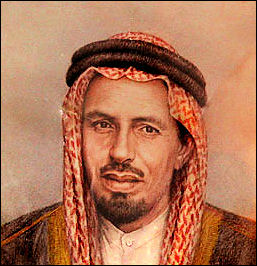
portrait of Muhammad bin
Awad bin Laden Osama bin Laden’s father Muhammad bin Awad bin Laden was born in Yemen. He rose from a being an illiterate bricklayer and porter to become billionaire who made a fortune in construction business, which he founded in Saudi Arabia in the 1930s.
Friends described Mohammed as a devout but not radical Muslim who was regarded as tough, smart and modest. Describing Mohammed, a pilot who used to fly the bin Laden family around told the Washington Post, “Everybody loved him. Maybe he didn’t go to school, but he had a realfeeling for engineering, and a real feel for how to hire good people.”
Michiko Kabutani wrote in the New York Times, “The ultimate self-made man, the family patriarch Muhammad bin Laden left an impoverished and deeply religious canyon village to seek his fortune and through a combination of skill, acumen and the assiduous cultivation of the royal family, became the king’s principal builder, overseeing renovations of sacred sites in Mecca, Medina and Jerusalem. He would bequeath to his children not just a fortune, but also what Mr. Coll calls a “transforming vision of ambition and religious faith in a borderless world.” [Source: Michiko Kabutani, New York Times, April 1, 2008; The Bin Ladens: An Arabian Family in the American Century by Steve Coll (Penguin Press, 2008)]
Life of Osama bin Laden’s Father
Mohammed bin Laden left his home in the family’s ancestral village in the Hadramawt mountains in a conservative province of southern Yemen and immigrated to what would soon become Saudi Arabia in 1931. He traveled on a perilous 1,000-mile journey to the Hijaz region in what is now Saudi Arabia. According to one story he was so poor that when he stopped in the pilgrim city of Jeddah he slept in a ditch he dug in the sand.
Mohammed bin Laden found work in Jeddha as a porter to the pilgrims on their way to the holy city of Mecca. Years later, after he became successful, he displayed his porter’s bag in the main reception room of his palace as a reminder of his humble origins. According to family tradition, he caught the attention of the future Saudi king, Abdul Aziz, while working on a palace in the Hijaz region by making suggestions on better ways for Aziz to get around the grounds in a wheelchair.
Milton Viorst wrote in the Washington Post: “Blind in one eye, not quite 30, Mohamed bin Laden emigrated from Yemen between the world wars, just as the Saudi oil boom was getting underway, and found a job as a bricklayer with Aramco, the Arabian American oil company. More than a good worker, he was an organizer, with an innate sense of business and engineering, and in 1935 he was helped by his employer to set up his own firm. Successful in building homes for princes, he won the notice of the king and erected one of the first royal residences. From there he advanced to the luxury palaces for which the ruling House of Saud is known, then to creation of the country's road network. He renovated the holy shrines in Mecca and Medina, and went off to restore Jerusalem's Mosque of Omar. He also built military installations to assure the Saud dynasty's security. [Source: Milton Viorst, Washington Post March 30, 2008; The Bin Ladens: An Arabian Family in the American Century by Steve Coll (Penguin Press, 2008)]
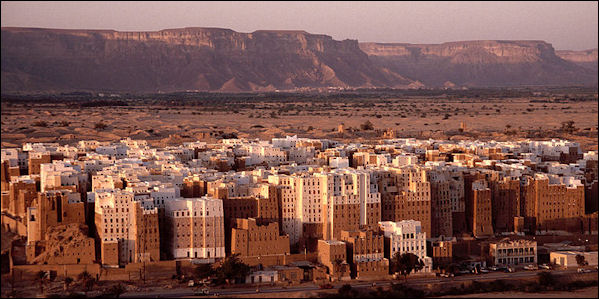
Shibam Wadi Hadramawt in southern Yemen
Osama bin Laden told Jamal Ismail, a Palestinian correspondent for Al Jazeera television, in 1998: “As it is well known, my father, Sheikh Muhammad bin Awad bin Laden, was born in Hadramawt [in southern Yemen]. He went to work in Hejaz [in Saudi Arabia] at an early age. Then God blessed him and bestowed on him an honor that no other building contractor has known. He built the holy Mecca mosque and at the same time — because of God’s blessings to him — he built the holy mosque in Medina. When he found out that the government of Jordan announced a tender for restoration work on the Dome of the Rock Mosque [in Jerusalem], he gathered engineers and asked them, “Calculate only the cost price of the project.” He was awarded the project. [Source: Peter Bergen, Vanity Fair, January 2006]
Mohammed bin Laden died on September 3, 1967 in a plane crash during the inspection of a construction site in the desert. His company airplane, a twin-engine Beechcraft, which was being flown by an American charter pilot, crashed as it attempted to land on a mountain airstrip in Saudi Arabia’s southern Asir province, where bin Laden had been overseeing road-construction projects. [Source: Steve Coll, The New Yorker, December 12, 2005]
Brian Fyfield-Shayler, a British citizen who lived in Saudi Arabia and taught English to a number of the bin Laden boys, told peter Bergen: “It was big news, national news, when [Osama’s father] was killed [in a plane crash in 1967]. And for the next year at least the future of the business [hung in the balance]. There were a lot of projects that were not completed, and it was the major construction company of Saudi Arabia, so it was of huge importance, and there was probably only Salem [Osama’s oldest brother] and three or four brothers at that period who were of an age even to take on the mantle. [Source: Peter Bergen, Vanity Fair, January 2006]
Osama bin Laden’s Father’s Family

Mohammed bin Laden kept four wives, often divorcing one so he could add another. In all he had 23 wives and 54 children. Most of the wives were Saudis or Egyptians. Each had their own house. Milton Viorst wrote in the Washington Post: “Like the Saudi royals, Mohamed bin Laden was rigorous in prayer but liberal in interpreting the Koran's sexual strictures. He married countless times, occasionally for business reasons, often out of whimsy, sometimes to women he kept with him, usually to women he legally divorced. In 1958 alone, his wives gave birth to seven children, among them Osama, whose mother was a 15-year-old Syrian from whom Mohamed quickly split. [Source: Milton Viorst, Washington Post March 30, 2008; The Bin Ladens: An Arabian Family in the American Century by Steve Coll (Penguin Press, 2008)]
Brian Fyfield-Shayler, a British citizen who lived in Saudi Arabia and taught English to a number of the bin Laden boys, told the writer Peter Bergen: “All the sons are very good-looking. I don’t think that I have ever met any ugly bin Ladens. Osama’s mother, I am told, was a great beauty. Since his father never had more than four wives at any one time, he was constantly divorcing the third and the fourth and taking in new ones. This was an anachronism even in the 1950s and 60s. [Source: Peter Bergen, Vanity Fair, January 2006]
Milton Viorst wrote in the Washington Post: “Although he acquired his children casually, Mohamed took his responsibility to them seriously. It was impossible to calculate his net worth...given the indifference to financial management in Saudi Arabia; the royal family alone may have owed him $100 million, which it would pay at its pleasure.But, following Islamic law,he willed each of his 25 sons 2.7 percent of his company's assets, while each daughter received 1 percent. These bequests assured them the means to finish their education and live comfortably, with a small surplus to help out their divorced mothers, who under Islamic law received nothing. [Source: Milton Viorst, Washington Post March 30, 2008; The Bin Ladens: An Arabian Family in the American Century by Steve Coll (Penguin Press, 2008)]
Osama bin Laden’s Father’s Connections and Businesses Interests
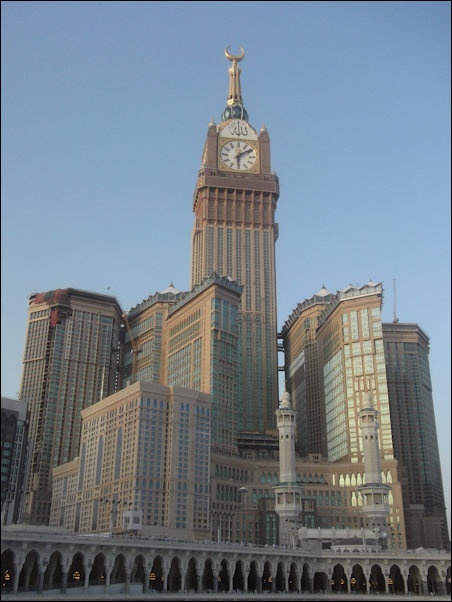
Abraj al-Bait Towers near the Kaaba in Mecca. Much of the construction and maintenance work for the Hajj is done by the Saudi BinLaden Group, the construction company founded by Osama bin Laden’s father.
Mohammed bin Laden owes much of his success and wealth to his connections with the Saudi royal family. He built palaces for member so the royal family and became especially friendly with King Faisal. Bin Laden supported Faisal in a power struggle between Faisal and King Saud and on at least one occasion helped Faisal pay angry civil servants and was rewarded with contracts for numerous public works and construction projects. These contracts made bin Laden a billionaire.
Kate Zernike and Michael T. Kaufman wrote in the New York Times: “The elder Bin Laden began his family’s rise by skillfully navigating the competing interests within and around the House of Saud in the 1950s. He first built palaces for the royal family and was then chosen to renovate holy sites, including those at Medina and Mecca. In 1958, when several Arab countries set about to renovate the Dome of the Rock and the Al Aqsa mosque in Jerusalem, on one of the holiest sites in Islam, he won the bid for the Saudis by offering to do the job at a loss. In interviews years later, Osama bin Laden would recall proudly that his father had sometimes prayed in all three holy places in one day. By the 1960s, King Faisal decreed that all construction projects be awarded to the Bin Laden group. [Source: Kate Zernike and Michael T. Kaufman, New York Times, May 2, 2011]
Michiko Kabutani wrote in the New York Times: “Muhammad bin Laden began his rise by working as a bricklayer and mason for Aramco, the Arabian American Oil Company, which had been formed to manage the oil rights of the Standard Oil Company of California, and that the huge international company that the bin Ladens built would come to do business with well-known American firms like General Electric, and draw on advice from the law firm Baker Botts, headed by James A. Baker III, the former secretary of state and Bush family adviser. [Source:Michiko Kabutani, New York Times, April 1, 2008; The Bin Ladens: An Arabian Family in the American Century by Steve Coll (Penguin Press, 2008)]
Osama bin Laden and His Mother and Father
Osama bin Laden’s father had four wives at any given time and had children with a total of women. Each of the wives and former waives had their own separate house and brought up their children.
Steve Coll wrote in The New Yorker: Bin Laden is the only child of the marriage between Alia Ghanem, who was born in Syria, and Muhammad bin Laden. Osama’s parents divorced soon after he was born, according to Khaled M. Batarfi, a Saudi journalist who knew Osama during the nineteen-seventies. Osama’s mother then married a man named Muhammad al-Attas, who worked at her former husband’s company. The couple had four children, and Osama lived in the new household with three stepbrothers and one stepsister. [Source: Steve Coll, The New Yorker, December 12, 2005]
There are are some stories that Osama is the only son of a woman from Syria or Palestine, who was not Mohammed bin Laden’s wife, and Alia Ghanem (Al Kalifa) was his adoptive mother. Alia Ghanem said Osama bin Laden had “always been a good son” to her and said she was “shy,” “very considerate,” and “loved and respected by his classmates and neighbors.” She added he liked playing soccer, riding horses and going on picnics.
When asked why he hated the West, Alia Ghanem said she believed it was because the West supported the enemies of Muslims. She said as a teen “he was frustrated about the situation in Palestine in particular, and the Arab and Muslim world in general. He wanted Muslims to unite and fight to liberate Palestine.”
Jamal Khalifa, bin Laden’s brother-in-law, said: [Osama] likes his father very much. He considered him as a model. He was not with his father much, because his father died when he was 10 years old. And, also, the father didn’t meet his children much. He was very busy — a lot of children, a lot of houses — so he just met them officially. There are 54 children, and he had 20-plus wives. [Source: Peter Bergen, Vanity Fair, January 2006]
Bin Laden Group Business Empire

Built by Saudi
BinLadin Group The Bin Laden Group is the name of billion dollar business empire owned by the bin Laden family. Headquartered in Jeddah, it has annual revenues of between $3 and $5 billion and is primarily a construction company but also has stakes in communications, media and manufacturing.
The Bin Laden Group has built roads, palaces, skyscrapers, mosques, power plants. airports and hotels. It shaped the skyline of Riyadh and carried out a major renovations of holy Islamic sites in Mecca, Medina and Jerusalem and other places. The bin Ladens are believed to have earned $10 billion from the renovations in Mecca and Medina thanks to inflated contracts given them by the Saudi royal family. The Bin Laden Group has also built military bases where American forces are based.
The bin Laden name is widely respected in the Middle East and international business circles. The is no evidence that the Bin Laden Group has given money or support to Osama bin Laden. The group lost contracts with companies like Cadbury Schweppes because of its ties with Osama bin Laden, avoids the media and hired a British public relations firm to help clear its name. After the attack on the World Trade Center in New York on September 11, 2001, the Saudi government dispatched a plane to pick up 22 bib Landens in the United States out of fear that they would be victims of reprisals.
As for the the Bin Laden Group’s support of Osama bin Laden and Al-Qaida, AP reported in 2007: The Saudi Binladin Group isn’t liable for the Sept. 11 attacks, attorneys for the multinational engineering firm claim, because it made Osama bin Laden surrender his stake in the company 14 years ago. Responding in federal court to lawsuits over the attacks, the lawyers wrote that in 1993, the terrorist mastermind was forced out as a shareholder in two companies his family owns. [Source: Larry Neumeister, Associated Press, September 4, 2011]
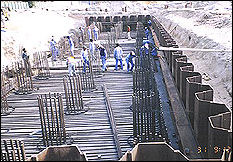
Saudi BinLadin Group
pilling division The company filed the defense papers in a U.S. District Court in answer to claims brought by representatives, survivors and insurance carriers of the victims. The plaintiffs, who seek billions of dollars in damages, allege the Saudi Binladin Group, along with numerous banks, charities and individuals worldwide, provided material support and assistance to al-Qaida prior to the attacks.
The plaintiffs contend Bakr Binladen — Osama bin Laden’s brother, the senior member of the bin Laden family and chairman of Saudi Binladin Group — was one of al-Qaida’s principal financiers.
Lawyers for Saudi Binladin Group said Bakr bin Ladin publicly renounced Osama bin Laden in a statement released to the media in February 1994. Two months later, the Saudi government revoked Osama bin Laden’s citizenship and froze his assets, the lawyers noted. Lawyers for the bin Laden family companies have said Osama bin Laden never received any buyout payment. They said the companies consulted with Saudi authorities, who directed that the money be placed in trust outside Osama bin Laden’s control... Earlier a judge had ordered Saudi Binladin Group to provide additional information about where the money for Osama bin Laden’s 2 percent stake in the company went.
Osama bin Laden’s Wealth
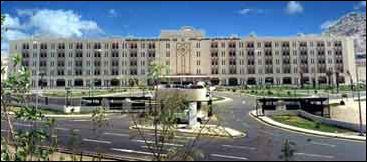
Built by Saudi BinLadin Group Osama bin Laden’s share of the inheritance after his father’s death in 1967 is believed to have been between $50 million and $300 million but more likely around $50 million or even less. He was regarded as a shrewd but sometimes careless businessman and a superb fund raiser. He is believed to have raised millions for Al-Qaida. He is also os believed to have squandered much of his own money on investments in Sudan and elsewhere.
Many believe the reports of Osama bin Laden’s great personal wealth are exaggerated. Bin Laden family members have said he has “a few millions” at most and much of it is tied up in accounts frozen by the Saudi government.Al-Qaida is believed to get much of its money from wealthy Muslims who hate America and support Al-Qaida’s goals and through money channels by Muslim charities.
The $300 million figure for Osama bin Laden’s wealth has been derived at somewhat dubiously by taking his fathers $5 billion fortune and dividing it by 20 male heirs. Many believe he only inherited around $30 million to $40 million, which is what minor heirs got. Following Islamic law, Mohammed bin Laden reportedly willed each of his 25 sons 2.7 percent of his company's assets. If this is true and Mohammed bi Laden’s wealth was $5 billion, Osama bin Laden would have gotten around $135 million.
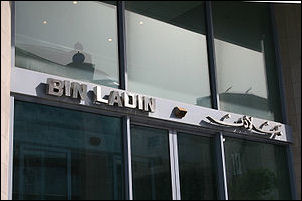
An investigation into Osama bin Laden wealth released in 2004 found that Osama bin Laden is not worth anything near the $300 million and his wealth is not used to fund terrorist attacks. Osama bin Laden told one interviewer that he lost around $150 million on failed construction and agriculture projects in Sudan. Some of his accounts have been frozen by the United States and Saudi Arabian governments. It is widely believed that whatever money he has is kept in secret accounts under a different name. Among his holdings at one time were trading companies in Kenya, a ceramic manufacturing company in Yemen, and a bank, construction firm and investment companies in Sudan. See Osama bin Laden in Sudan.
On how much money Osama bin Laden inherited from his family, Peter Bergen wrote in Vanity Fair: “Certainly far less than the $200 million or more mentioned in the media after 9/11. In fact, according to someone designated by the family to speak to me, bin Laden benefited from the distribution of his father’s estate according to Sharia law, which says that sons receive twice as much as daughters. However, with 54 children, even Muhammad bin Laden’s vast fortune did not go too far. Until Osama’s family cut him off, in 1994, he had probably received something like $20 million.” [Source: Peter Bergen, Vanity Fair, January 2006]
Osama bin Laden’s financial worth has remained in dispute. The Sept. 11 commission concluded that the Sudanese government took Osama bin Laden’s assets when he left the Sudan in 1996. “He left Sudan with practically nothing,” the commission concluded. “When bin Laden arrived in Afghanistan, he relied on the Taliban until he was able to reinvigorate his fundraising efforts by drawing on ties to wealthy Saudi individuals that he had established during the Afghan war in the 1980s.” [Source: Larry Neumeister, Associated Press, September 4, 2011]
Many think he lived off of money he earned from fund-raising for Al-Qaida not family wealth. Some have speculated that he may have siphoned off Al-Qaida funds to take care of himself and his large family.
Osama bin Laden’s Siblings

Osama (extreme right) with
half brother Yeslem
Bin Laden in Oxford (maybe) Osama bin Laden has 54 brothers and sisters from more than 20 different mothers. The children were brought up in different households but were expected to follow a tight daily regimen prescribed for them by their father.
After Osama bin Laden’s father died the children were raised by their mother and a committee of five or six people appointed by the Saudi royal family. The committee ran the bin Laden business empire and played a role in raising the children. Yeslam Binladin told Newsweek, “The king always had the final word. He kept the family together. I feel like [the royal family] is my family. We are devoted to them and honored to serve them.”
Many of Osama bin Laden’s brother and sisters became very Westernized and made their homes in Europe and the United States. Some even changed their citizenship. At the time of the attack on the World Trade Center in New York on September 11, 2001, 15 siblings were living in Europe and four brothers and 17 nieces and nephews were in the United States. One brother, Abdullah, studied at Harvard. Osama’s half brother Yeslem Bin Laden has released his own French-made perfume. Largely regarded as the ant-thesis of Osama, he devotes much of his energy to recreational pursuits: he drives Porsche, skis, flies his own planes and is a ranked tennis player in Switzerland where he spends most of his time.
Michiko Kabutani wrote in the New York Times: While he careered toward violence, other members of his family moved to strengthen their ties with the West. There were family investments in enterprises ranging from Iridium, a satellite communications network, to the Hard Rock Cafe franchise in the Middle East. In the days after 9/11 Prince Bandar bin Sultan, the Saudi ambassador in Washington — who met with President Bush on the evening of September 13 — helped arrange (with F.B.I. permission) a special chartered plane flight to carry more than a dozen bin Ladens, some of whom had been living in the United States for years, back home to Saudi Arabia. Subsequent F.B.I. investigations “turned up no evidence of complicity by the bin Laden family in terrorist violence.” Steve Coll wrote in his book about the bin Ladens that the a decision seems to have been made at the White House sometime early in 2002 that, barring the emergence of new evidence, “the U.S. government would not sanction the bin Laden family in any way because of its history with Osama.” One F.B.I. analyst said there were “millions” of bin Ladens “running around” and “99.999999 percent of them are of the non-evil variety.”[Source: Michiko Kabutani, New York Times, April 1, 2008; The Bin Ladens: An Arabian Family in the American Century by Steve Coll (Penguin Press, 2008)]
Salem bin Laden
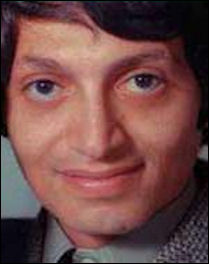
Salem bin Laden After Mohammed bin Laden died in 1967, his oldest son Salem took over the family business. He was a daredevil pilot who himself died in a plane crash in 1988. Steve Coll wrote in The New Yorker that according to Batarfi: The leader of this side of the family then was Muhammad bin Laden’s eldest son, Salem, an ebullient, guitar-playing graduate of an English boarding school. By the mid-nineteen-seventies, Salem had acquired a private jet, and he travelled widely, to Switzerland, England, and Texas.” In Texas he befriended Jim Bath, a former reserve pilot with the Texas Air National Guard who used to hang out with George W. Bush. Bath later became a business partner in Houston with Salem. [Source: Steve Coll, The New Yorker, December 12, 2005]
Brian Fyfield-Shayler, a British citizen who lived in Saudi Arabia and taught English to a number of the bin Laden boys, told Peter Bergen: “Salem was educated at Millfield [a boarding school in England]. Salem was a fraction younger than me, but not much. I was introduced to him by mutual friends. He was very Westernized. His English was beautiful; it was very fluent, very characterful. [Source: Peter Bergen, Vanity Fair, January 2006]
Michiko Kabutani wrote in the New York Times that Salem took over the Bin Laden Group after his father’s death and “would expand its international reach, and he would also embrace a Westernized, jet-set existence that allowed him to indulge his eccentricities to the fullest.” In Steve Coll’s depiction if him in his book abook about the bin Laden’s Salem emerges “as a compelling, larger-than-life figure, a picaresque playboy, at once guileless, brilliant and self-indulgent, who held together the increasingly fractious bin Laden clan through sheer force of will and charisma. Salem, who dressed in jeans, loved airplanes and liked to play the harmonica, reportedly “paid a bandleader at an Academy Awards party in Los Angeles hundreds of dollars to let him sing “House of the Rising Sun” in seven languages.” [Source: Michiko Kabutani, New York Times, April 1, 2008; The Bin Ladens: An Arabian Family in the American Century by Steve Coll (Penguin Press, 2008)]
“Mr. Coll reports that Salem organized family expeditions to Las Vegas, shipped thousands of cases of Tabasco sauce back to Saudi Arabia and dreamed of marrying four women from four Western nations: his estate, he imagined, would resemble the United Nations, with four houses, one flying an American flag, one a German flag, one a French flag and one the Union Jack.
A relative of the bin Laden family told Peter Bergen: “Salem was a unique individual by any standard. By Saudi standards he was off the charts. Very charismatic, amusing, no facial hair. He played guitar — 60s hits like “Where Have All the Flowers Gone.” He acted as sort of a court jester to King Fahd and was part of Fahd’s inner circle. Sometimes he overstepped with the king. One time he buzzed the king’s camp in the desert with one of his planes, which went down badly, but he was always taken back into the fold. Salem took control of the business beginning in ‘73-‘74. If King Fahd wanted a palace built, Salem would build it for him. [Source: Peter Bergen, Vanity Fair, January 2006]
Bergen wrote: “On May 29, 1988, Salem, Osama’s brother, crashed a plane in San Antonio, Texas, and died on impact. Although Salem did not see much of Osama, because Salem was running the family business and was far more fun-loving and Westernized than his austere younger half-brother, his death was a blow to Osama.” Alia Ghanem, Osama bin Laden’s mother, said, — His older brother Salem was like a father to him after the death of their father, Muhammad. Salem’s death saddened Osama a great deal.”
A bin Laden relative told Bergen: “If Salem had still been around, no one would be writing books about Osama bin Laden. Salem had a volcanic temper and had no problem about rocking the boat. He would have personally flown to Sudan [where Osama lived in the mid-90s]. Salem would have grabbed Osama by the lapels and taken him back to Saudi Arabia.”
.png)
Bin Laden Family tree
Osama bin Laden’s Wives
Steve Coll wrote in The New Yorker: Bin Laden — is known to have married at least four times. His first wife was a cousin from Syria. His second and third wives were highly educated Saudi women. His fourth wife was a kind of mail-order teen-age bride from Yemen, whom he married while living in Afghanistan during the nineteen-nineties, according to the account of bin Laden’s former Yemeni bodyguard. [Source: Steve Coll, The New Yorker May 2, 2011]
Wisal al Turabi, a friend of Osama bin Laden’s family in Sudan and wife of Hassan Turabi, who became the de facto leader of Sudan after a coup in 1989, told Peter Bergen: “I met [one of bin Laden’s wives], Umm Ali [i.e., the mother of Ali], in her house. I didn’t see her children, but she said the children were in another room trying to learn the Koran. She was a university lecturer. She was very knowledgeable, because she studied in Saudi Arabia. She used to go to Saudi Arabia and come during her holidays to stay in Khartoum. She was teaching Islam to some families in Riyadh [an upscale neighborhood in Khartoum]. [Source: Peter Bergen, Vanity Fair, January 2006]
“Three of his wives are university lecturers; the first one is not. He has four wives. And he married the other three because they were spinsters. They were going to go without marrying in this world. So he married them for the Word of God. In Islam we do this. If you have a spinster, if you marry her, you will be rewarded for this in the afterworld, because you will bring up your offspring as Muslims.”
Abu Jandal, bin Laden’s former chief bodyguard, told the interview with the London-based Arabic newspaper Al-Quds al-Arabi, 2004: “His wife Umm Ali asked Sheikh Osama for a divorce when they still lived in Sudan. She said that she could not continue to live in an austere way and in hardship. He respected her wish and divorced her in accordance with the Koranic verse “Husband and wife should either live together equitably or separate in kindness.” The other wives stayed with him, however, although they come from distinguished families and are highly educated.”
Osama bin Laden’s Sons
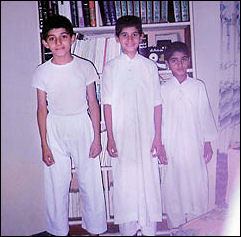
Bin Laden's sons
Saad, Osman and Mohammed Some of Osama bin Laden’s sons are in Saudi Arabia, working for the Bin laden Group construction company. In a video released during the beginning of the American invasion of Afghanistan war one of Osama bin Laden’s sons is shown reading poetry and another stands by with a grenade launcher in front of the wreckage of a downed U.S. helicopter.
Hamid Mir, a Pakistani journalist who had interviewed bin Laden, said: “I met three [of his] sons. Muhammad, Ali, Saad, [who] is in Iran [now]. [Saad was] 16. I had a picture with Saad sitting with his father, and a gun is lying in his lap, and I asked bin Laden, “He is a young boy. Why is he carrying a gun?” And he said that this is his own decision. So I asked a question to Saad: “Are you following the footsteps of your father?” And he answered very confidently, “No. I am following the footsteps of my Prophet.” [Source: Peter Bergen, Vanity Fair, January 2006]
In 2005, bin Laden’s eldest son, Abdullah ran the Fame advertising agency in Jeddah with 15 employees. He was with his father in Sudan and Afghanistan. In 1995, with his father’s blessing he left for Jeddah to start his business. “Fame...Is Your Fame” was the agency’s slogan. “Event Management” was one of their specialties. Some of their promotional material read: “Fame Advertising event are novel, planned meticulously and executed with efficiency.” [Source: Steve Coll, The New Yorker, December 12, 2005]

Osama bin Laden's children Some of bin Laden’s sons are believed to have taken active roles in Al-Qaida. Saad bin Laden, Osama’s forth oldest son, is said to have been involved with providing financing and logistical support for the group. He was named as a possible successor to his father. Another son, Mohammed, is believed to have been active on the organization. He is married to the daughter of killed Al-Qaida lieutenant Mohammed Atef and may have helped organize the bombing of a Tunisian synagogue. He sometimes acted as a bodyguard for his father. Osama bin Laden’s two oldest sons reportedly have distanced themselves from their father.
Saad bin Laden, one of Osama bin Laden’s oldest son, emerged as a high-ranking member of Al-Qaida and a possible successor to his father. His was connected with May 2003 bombings in Riyadh that left 35 people dead and in Casablanca that killed 4.
Saad bin Laden was born in Saudi Arabia around 1980 to Osama bin Laden and his first wife. He was at his farther’s side when he fought in Afghanistan and founded Al-Qaida in Pakistan. Saad is fluent in English and is said to be good with computers. He is thought to currently live in Iran, where he is protected by elite, radical, Iranian security forces loyal to Iran’s clerics. The secretive unit, know as the Jerusalem Force, keeps tabs on the Al-Qaida members and keeps them in their bases, mostly near the Afghanistan border.
David Brown wrote in The Times: Omar bin Laden left Saudi Arabia as a child when his father was expelled for his extremist beliefs, his wife said. Living in exile in Sudan and then Afghanistan, he saw at first hand the creation of al-Qaeda and its techniques. Mrs Jane Felix-Browne, his 50 something British second wife, said: “I never had any problem with his past. Omar did not do anything wrong. He was a child when he was in Afghanistan.” [Source: David Brown, The Times, July 11, 2007]
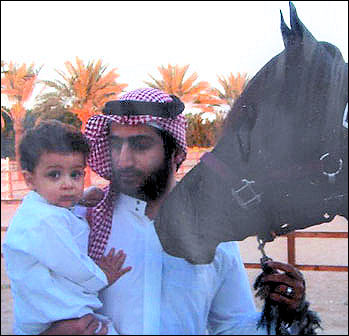
Osama bin Laden's son Omar
and grandson Felix-Browne told The Times that her husband left Afghanistan before the attacks on the U.S. on September 11, 2001. However, some reports claim that he split from his father only after the attack on New York and had an argument with him about tactics. Felix-Browne insisted: “He last saw his father in 2000 when they were both in Afghanistan. He left his father because he did not feel it was right to fight or to be in an army. Omar was training to be a soldier and he was only 19. “He told me he has had no contact with his father since the day he left him. He misses his father. Omar doesn’t know if it was his father who was responsible for the 9/11 attacks. I don’t think we will ever know.”
Omar bin Laden works as a scrap metal dealer in Jedda. His father’s reputation means that he has been ostracised by the wealthy and powerful bin Laden family and is under surveillance by the security services in Saudi Arabia. Felix-Browne, who now uses the Islamic name Zaina Mohamad, says that she speaks to her husband for several hours every day over the internet or by telephone. During their conversations she refers to him repeatedly as “Habibi”, Arabic for “My Love”. She said: “I find it very difficult to live without him and I know he does too. But really we have the most normal life possible.” Felix-Browne told The Times she was aware before her marriage that her husband already had another wife and a two-year-old child. “I haven’t seen her but I have spoken to her for about an hour on the telephone,” she said. “She is fine about it.”
Image Sources: Wikimedia Commons except Saudi bin Laden Group images from Saudi bin Laden Group website and Osama bin Laden family pictures from Time Magazine and Osama bin Laden in Oxford from Carmen bin Ladin, former wife of Yeslam bin Ladin, Osama’s older half-brother, from her 2004 book, Inside the Kingdom
Text Sources: New York Times, Washington Post, Los Angeles Times, Times of London, The Guardian, National Geographic, The New Yorker, Time, Newsweek, Reuters, AP, AFP, Wall Street Journal, The Atlantic Monthly, The Economist, Global Viewpoint (Christian Science Monitor), Foreign Policy, Wikipedia, BBC, CNN, NBC News, Fox News and various books and other publications.
Last updated July 2012
